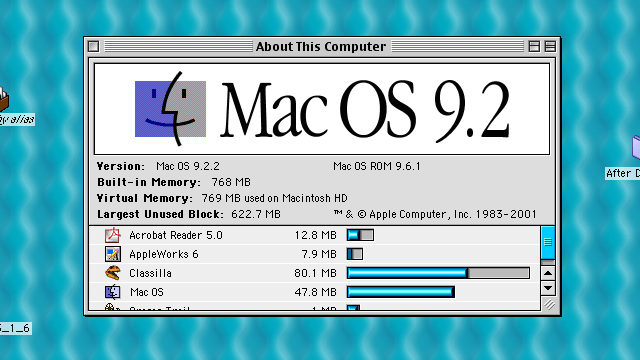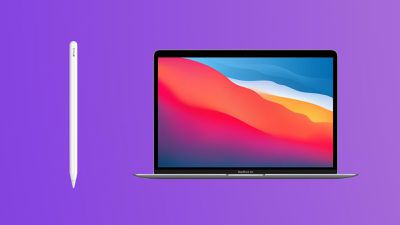Illa than ill
Cameron Kaiser develops OS 9 Web browser Classilla and its PPC OS X counterpart TenFourFox(as the names suggest, both are based on Mozilla’s Firefox browser). As Cunningham found, even with a browser under (semi-)active development, the Web is horrible on OS 9. Many websites are completely unusable. Ars just barely scrapes by. Social networking sites like Facebook and Twitter are down to the barebones, too. This, Kaiser notes, is often enough all on its own for many people to justify leaving Apple’s classic Mac OS in the last millennium. “I really intensely dislike the idea that the ability to run Facebook is the sole determining factor of whether a computer is obsolete to some people,” he told me over e-mail. “But that’s the world we live in now.”
In terms of raw computing power, however, Kaiser says that G4 and G3 Macs have the necessary power to properly load most sites on the Web. He notes that comparable Pentium 3 and 4 systems cope fine with light browsing of the modern Web, so the problem facing OS 9 as a platform for going online is instead its software. Things like toolchain support and drivers and OS-level implementations of things like multithreading and multiprocessing are where the OS 9 environment is lacking. With Classilla, Kaiser is very, very slowly battling against these.
“I don’t think anyone who worked on the Mac OS 9 compatible Mozilla will dispute the build system is an impressive example of barely controlled disaster,” he says. It uses scripts and hacks and only actually builds into an executable app under very finicky, hard-to-replicate conditions that Kaiser suggests scared away “all but the most motivated (or masochistic) contributors” to both Classilla and the original OS 9 branch of the Mozilla project.
The longterm viability of Classilla development is harmed by toolchain limitations. Kaiser sings the praises of the CodeWarrior IDE (that’s short for integrated development environment, or “app used to write, fix, and maintain code” in layman’s terms). But the code he inherited from Mozilla was essentially locked to a specific version of CodeWarrior that isn’t compliant with the newest versions of the C++ programming language. This means Classilla’s JavaScript interpreter will remain painfully slow, and it’s unlikely to get much of anything from newer versions of Mozilla’s Gecko layout engine.
“I find these challenges stimulating,” he says. “I like the feeling of getting something to do tasks it wasn’t originally designed to do, sort of like a utilitarian form of the demoscene.” Kaiser believes such constraints force creative, innovative solutions to some problems and serious breaches of coding best practices for others. “Making the browser into a series of patches upon patches is surely asking for trouble, but there’s something liberating about that level of desperation,” he continues. “Anything from amazingly bad hacks to simply accepting a certain level of wrong behavior in one module because it fixes something else in another to ruthlessly saying some things just won’t be supported, so there.”
Kaiser’s decisions about the best way forward for Classilla don’t always go down well with all of the browser’s few thousand or so users. The most controversial change came in 2012, when he altered its user agent to prefer mobile content. This worked pretty well at the time, since most of the mobile-optimized Web was very lightweight and simple. “I even ate my own dogfood and took nothing but an OS 9 laptop with me on the road periodically,” he says. “It was enough for e-mail, some basic Google Maps, and a bit of social media.” (Kaiser told me he once took it to tech journalist Leo Laporte’s podcast studio, much to Laporte’s wonderment.)
Few people still use Classilla for anything more than accessing internal sites or files on a server, so Kaiser shifted his limited development time (TenFourFox and his day job keep him busy) to just improving his own browsing experience by introducing site-specific optimizations. However, at least one of his users genuinely needs the dev support. “I get occasional reports from one user who for reasons of his particular disability cannot use OS X,” Kaiser says. “Classilla is pretty much his only means of accessing the Web.
Music to their ears
The largest concentration of OS 9 diehards seems to be in audio production and music composition. The Mac has long been popular in the sound-making business, so there’s a plethora of professional software and hardware available for OS 9. Two favored digital audio workstations (DAWs) from the era, DigiDesign’s Pro Tools 5 and Prosoniq’s SonicWORX Power Bundle, were both made freeware in the mid-2000s. Other old DAWs are cheap to buy secondhand and easily pirated. That’s only the enabling factor, however—these users also hold a reverence for classic Mac OS.
This goes back to the days when Macs were criticized for dumbing down computing, as though it were a bad thing that your grandparents could operate a computer. Apple stringently followed its own human interface guidelines, and the Macintosh community expected third-party developers to do so, too. The result was that you could predict how most things would work, and this made it easier to offload mental processing such that you could do stuff on autopilot. Once you recognized the logic to it, the interface disappeared.
Classic Mac OS proponents like to single out thespatial Finder in particular as one of OS 9’s biggest advantages over OS X and Windows. They deem it more intuitive, more natural, more coherent than the Windows Explorer or OS X versions of the Finder. As John Siracusa wrote, in the spatial Finder “each window is permanently, unambiguously associated with a single folder” and everything stays where you left it in the manner in which you left it. For this reason, one person I talked to, Emilio Souto, argued that the classic Mac OS interface is better than anything released since. “The mix of power and simplicity of this system is unique,” he said. “It’s pure art. The Mac OS 9 environment is easy to use and troubleshoot. It doesn’t disturb you from doing your main work, be it audio or whatever.”
You could describe OS 9 as a thinner operating system than modern-day Windows and OS X. “I’ve heard it said that OS 9 is just a loose jumble of libraries stacked under a file browser,” says Kaiser. “That’s really not too far off. The kernel, if you can call it that, is nearly non-existent—there’s a nanokernel, but it’s better considered as a primitive hypervisor. There is at best token support for memory protection and some multiprocessing, but none of it is easy and most of it comes with severe compromises.”
It’s definitely flawed, but these problems happen to also make it super fast and responsive. Even my 700 MHz iBook G3 flies when I boot it into OS 9 (as does my 300 MHz PowerBook G3 on OS 8.6). OS 9 feels noticeably snappier on a G4 machine than El Capitan does on a new Core i7 Mac with SSD storage. Audio people love this. They claim that the latency on their virtual instruments and recording and monitoring gear in OS 9 is miles better than anything else.
Swap back and forth repeatedly between the latest version of OS X and a Power Mac running OS 9, and you see what they’re getting at. Even the simplest tasks suddenly feel weighed down on OS X. In OS 9, you open a new Finder window and it appears instantaneously—with a subtle, almost-subliminal wireframe animation from the point of origin to its screen position. Do the same thing in El Capitan, and you have time to quickly glance away and back again before the window pops into existence.
Community
I found several websites and two Facebook groups meant as meeting places for classic Mac OS diehards, even including one for using System 7 today. But all but two of these seem to be ghost towns today. One of the two I already mentioned—the Facebook group “Mac OS 9 – it’s still alive!”—has fewer than 200 members and sustains mostly lighthearted discussion. The other is a website called Mac OS 9 Lives, which hosts a thriving audio-focused forum with around 1,500 members.
Bob “mrhappy” Boyer is one of the community members here. He works as a musician, producer, and audio engineer in a 10-piece band and at a recording studio. In the studio he works with modern gear, but at home it’s a different story. “Six years ago or so,” he tells me, “I began trying to ‘modernize’ my home setup, as it was still based around reel to reel tape recorders and Mac OS 9 gear.” He soon realized that it’d take a far larger financial investment than he could afford. A few years later, he noticed how cheap the older pro gear was getting. Tools and equipment that would have cost a fortune a decade ago were being abandoned or sold for a tiny fraction of their original price.
Boyer fell down the rabbit hole, so to speak. He has constructed his home studio around a Digidesign ProControl mixing and recording console and a Power Mac G4 running ProTools 5.1.3. Connected to that Mac via its four PCI expansion slots, he has an array of mixer cards and “other ‘obsolete’ items.” The setup would have cost tens of thousands of dollars 15 years ago, but he scrounged it together for far less off sites like eBay and Craigslist over the last few years.
“It can be quite fun being on the ‘cutoff’ edge and acquiring things/tools that I used to drool over back in the day,” Boyer says. All this old pro audio gear serves him well for writing, recording, and mixing his own music as well as for working on any bits he wants to bring home from the studio to finish.
The raw processing power of these older Macs does at times fall short of what’s required—or at least required to work without costly compromises. One senior forum member, Roman Thilenius (who goes by the handle IIO), explains that real-time processing “is the most effective way to do creative work” in audio and video production. Even the latest Intel-based computers sometimes fall to their knees beneath the load of real-time production, but PowerPC Macs from the turn of the century cross that threshold much sooner. Thilenius tells me he has built some custom audio software on his G4 that won’t actually work on the machine because it’s too slow.
Those custom audio apps may get a lifeline if any one of the community’s ambitious efforts to modify OS 9 succeeds. They’re aiming to make Mac OS 9 accept more powerful hardware. Not new PowerPC processors (yes, PowerPC lives on today in some areas of research, in game consoles such as the Wii U and as a CPU platform of choice for Amiga hobbyists). Nor x86 or x64 systems like the latest Intel Macs. They’re thinking more modest: late-model PowerPC Macs.
Professional dream machine
Mac OS 9 as a bootable system was phased out in all of Apple’s computer product lines before the switch to Intel circa 2005-2006. None of the aluminum PowerBooks support native booting of OS 9. Nor do the G5-based PowerMacs and iMacs—though getting OS 9 to run on these is a kind of Holy Grail.
The classic Mac community has been working in earnest to get OS 9 booting on late-model G4s. Their success so far has been mixed. Think Classic forum member iMic got the ball rolling by hacking away at the OS 9 hard disk drivers and Mac OS ROM, which through a long trial and error process and help from several others eventually resulted in OS 9 functioning on late-model G4 iMacs/eMacs and early iBook G4 and aluminum PowerBook G4 models. Mac OS 9 Lives forum member nanopico picked up on this work and started digging deeper into the inner workings of the operating system in late 2015 with an eye toward spearheading a community-made OS 9 update.
He has already made some cool discoveries. Nanopico determined last year that if you have 2GB of RAM installed, the last 500MB is initialized to zero—it’s seen but left unused. You don’t get to use it because the memory management unit (MMU) stops mapping physical RAM to its virtual address space at 1.5GB. Raising the RAM limit to 2GB or possibly even 4GB—the theoretical limit for a 32-bit operating system such as OS 9—might be doable if they can write a patch that changes how the MMU is initialized. Alternatively, the community might be able to create a RAM disk with the extra memory to use as a scratch area for faster video/audio/photo editing.
Nanopico told me he relishes the challenge of hacking into Mac OS 9. Once he heard that unsupported G4s were beginning to run OS 9, he decided to try to prove it could get on G5s, too. Whether he succeeds or not, he has already made his life better.
“At work I’ve been on an extremely large project for a couple of years that has been so draining on me mentally that I got to the point where I hated computers,” he says. “I hated programing and I just wanted to be done.” This pet project has reminded him why he loves programming, which has improved his morale and work productivity.
He’s not just in it for the challenge. Nanopico liked OS X less and less since 10.5 came out, and he’s critical of Linux—which he used “almost exclusively” from 2004 to 2009 but now describes as a kind of Frankensteinian monster made from the worst parts of OS X and Windows Vista. He loves how fast OS 9 runs on slow hardware and how its extensions system makes it easy to tweak how the OS functions and to patch its shortcomings—provided you can figure out what to patch.
That’s kind of where this community-made OS 9 update stands—exploring the OS on a low level to determine what to patch and how. Nanopico’s learning a lot and gradually gaining insights into things not publicly documented, like how the memory management unit works, but he tells me there’s little to show so far. There’s no proof of concept or working demo. Not yet, anyway. “I’m getting close to a point where I can start writing some code to test the knowledge I’ve gained and start designing the patches required to enhance OS 9,” he says. But that’ll probably take a whil.
Will you still need me?
When I began working on this story, I thought I might find a bunch of fanatics who refuse against logic or reason to get with the times. But for most adherents to the ways of OS 9, that doesn’t appear to be the case.
In our modern world of planned obsolescence and yearly OS releases, it’s easy to just go with the flow. Many users upgrade because everybody else is doing it or simply because Apple and Microsoft told them to. But perhaps we can take a lesson from the determination of these classic Mac OS holdouts—to not jump onto the shiny new thing so quickly and to think about whether we really stand to benefit from an upgrade. If security is being accounted for somehow, someway, how many of the bells and whistles announced with every software or hardware refresh do you end up using or liking? Do they make your life easier? Or just slightly different?
Above all, the dedication of these OS 9 holdouts to stick to what they love is a reminder that personal computing is—as the term implies—very much personal. When asked by Conan O’Brienwhy he still uses DOS program Wordstar 4.0 to write his books, Game of Thrones author George RR Martin explained simply that he likes it. “It does everything I want a word processing program to do, and it doesn’t do anything else,” he continued.
Everyone who clings to an old “obsolete” computer system is the same—whether it’s OS 9, DOS,Amiga, or anything else. It meets their needs, and it doesn’t bother with “features” they deem extraneous. Given that straightforward value proposition, expect Mac OS 9 to stick around through a few more of those macOS releases.
Richard Moss is a writer and technology/games historian based in Melbourne, Australia. His first book,The Secret History of Mac Gaming, is due out in 2017. He also produces Ludiphilia, a storytelling podcast about how and why we play. You can follow him on Twitter @MossRC
[Source:-Ars Technica]







